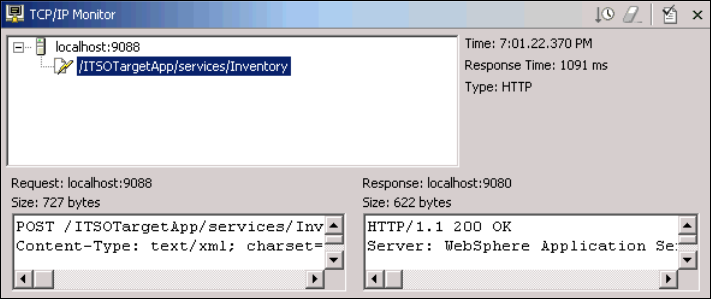
210 Broker Interactions for Intra- and Inter-enterprise
TCP/IP Monitor Server
The TCP/IP Monitor Server provided with WebSphere Studio Application
Developer (shown in Figure 8-42) also allows tracing of SOAP messages. It
works in a similar way to the WebSphere TCPMon tool. To use the TCP/IP
Monitor Server, create a new Server and Configuration and select Other
→
TCP/IP Monitor Server for the server type.
Figure 8-42 Tracing SOAP messages using WebSphere Studio TCP/IP Monitor Server
Back up your configuration.
The Web Services Gateway offers a very easy way to make a backup of the
entire configuration of the gateway. This backup does not include the filter
implementation, which resides in a separated Enterprise Application.
8.7 Quality of service capabilities
In this section we discuss Quality of Service capabilities and considerations
specific to the Web Services Gateway.
8.7.1 Performance and availability
In this section we discuss considerations regarding performance and availability.
SOAP Caching
SOAP caching can significantly improve the performance of Web services. The
SOAPAction HTTP header in the request is defined in the SOAP specification
and is used by HTTP proxy servers to dispatch requests to particular HTTP
servers. WebSphere Application Server dynamic cache can use this header in its
cache policies to build IDs without having to parse the SOAP message.

Chapter 8. Router solutions using Web Services Gateway 211
Application server clustering
The Web Services Gateway is a J2EE enterprise application that runs on
WebSphere Application Server. This means that in a Network Deployment
environment, clustering of application servers can be used to improve
performance and availability.
For information on WebSphere Application server clustering, see IBM
WebSphere V5.0 Performance, Scalability, and High Availability, SG24-6198.
8.7.2 Security
Security is one of the crucial QoS aspects which needs to be addressed when an
enterprise plans to expose their internal applications to partner organizations.
The following topics address Web Services Gateway security features.
Invocation of services using SSL
As a request passes from one component to another, the opportunities for the
interception and exposure of information increase and ultimately the overall
security of a system directly relates to the weakest, or least secure, point. SSL
can be used to secure connections between two endpoints.
WebSphere Application Server, and the Web Services Gateway support SSL
connections.
Basic authentication and authorization facilities
Web Services Gateway provides a basic authentication and authorization
mechanism based upon the broader security features of WebSphere Application
Server.
Basic authentication can be applied at two levels:
Gateway-level authentication
Web service operation-level authorization
For gateway-level authentication, you set up a role and realm for the gateway on
WebSphere Application Server's Web server and servlet container, and define
the user ID and password that is used by the gateway to access the role and
realm. You also modify the gateway's channel applications so that they only give
access to the gateway to service requesters that supply the correct user ID and
password for that role and realm.
Note: This means that gateway-level authentication must be enabled before
you install any channels

212 Broker Interactions for Intra- and Inter-enterprise
For operation-level authorization, you apply security to individual methods in a
Web service. To do this, you create an enterprise bean with methods matching
the Web service operations. These EJB methods perform no operation and are
just entities for applying security. Existing WebSphere Application Server
authentication mechanisms can be applied to the enterprise bean. Before any
Web service operation is invoked, a call is made to the EJB method. If
authorization is granted, the Web service is invoked. Your target Web service is
protected by wrapping it in an EAR file, and applying role-based authorization to
the EAR file.
WS-Security
Because the Web Services Gateway deals with SOAP messages at the
application level, you are introducing the potential for a security risk. Securing the
message at the transport protocol level is not sufficient. WS-Security describes
how to secure messages using XML encryption and XML digital signature and
how to integrate these specifications into a SOAP message.
Web Services Gateway can be configured for the secure transmission of SOAP
messages using tokens, keys, signatures and encryption in accordance with the
Web Services Security (WS-Security) draft recommendation.
In a normal (non-gateway) WS-Security scenario, the flow is as shown in the
following figure:
Notes:
If you want to enable operation-level authorization, you must first enable
gateway-level authentication.
If you want to change the default gateway-level authentication settings,
you must do so before you install any channels.
After gateway-level authentication has been enabled, filters have access to
the requester's authentication information.
Get Patterns: Broker Interactions for Intra- and Inter-enterprise now with the O’Reilly learning platform.
O’Reilly members experience books, live events, courses curated by job role, and more from O’Reilly and nearly 200 top publishers.

